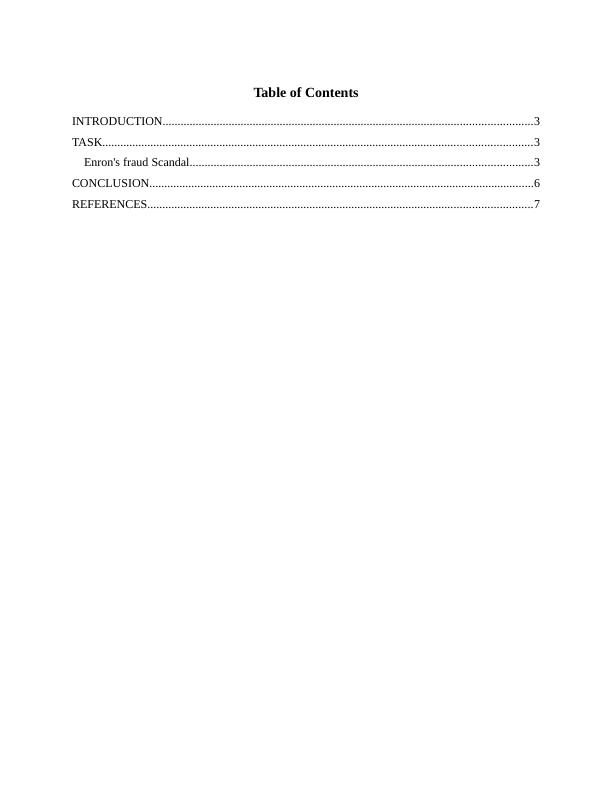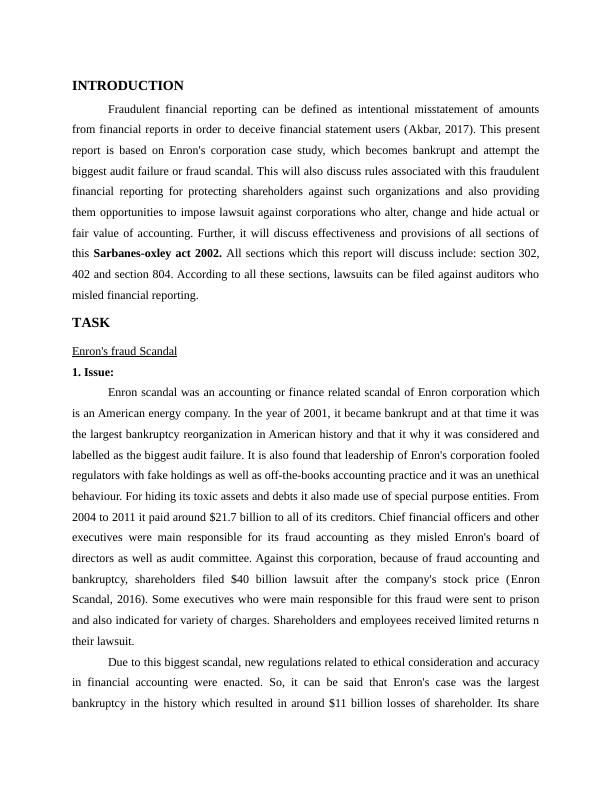Enron's Fraud Scandal and the Sarbanes-Oxley Act 2002
Added on 2023-01-05
12 Pages1916 Words1 Views
Individual Report

Table of Contents
INTRODUCTION...........................................................................................................................3
TASK...............................................................................................................................................3
Enron's fraud Scandal..................................................................................................................3
CONCLUSION................................................................................................................................6
REFERENCES................................................................................................................................7
INTRODUCTION...........................................................................................................................3
TASK...............................................................................................................................................3
Enron's fraud Scandal..................................................................................................................3
CONCLUSION................................................................................................................................6
REFERENCES................................................................................................................................7

INTRODUCTION
Fraudulent financial reporting can be defined as intentional misstatement of amounts
from financial reports in order to deceive financial statement users (Akbar, 2017). This present
report is based on Enron's corporation case study, which becomes bankrupt and attempt the
biggest audit failure or fraud scandal. This will also discuss rules associated with this fraudulent
financial reporting for protecting shareholders against such organizations and also providing
them opportunities to impose lawsuit against corporations who alter, change and hide actual or
fair value of accounting. Further, it will discuss effectiveness and provisions of all sections of
this Sarbanes-oxley act 2002. All sections which this report will discuss include: section 302,
402 and section 804. According to all these sections, lawsuits can be filed against auditors who
misled financial reporting.
TASK
Enron's fraud Scandal
1. Issue:
Enron scandal was an accounting or finance related scandal of Enron corporation which
is an American energy company. In the year of 2001, it became bankrupt and at that time it was
the largest bankruptcy reorganization in American history and that it why it was considered and
labelled as the biggest audit failure. It is also found that leadership of Enron's corporation fooled
regulators with fake holdings as well as off-the-books accounting practice and it was an unethical
behaviour. For hiding its toxic assets and debts it also made use of special purpose entities. From
2004 to 2011 it paid around $21.7 billion to all of its creditors. Chief financial officers and other
executives were main responsible for its fraud accounting as they misled Enron's board of
directors as well as audit committee. Against this corporation, because of fraud accounting and
bankruptcy, shareholders filed $40 billion lawsuit after the company's stock price (Enron
Scandal, 2016). Some executives who were main responsible for this fraud were sent to prison
and also indicated for variety of charges. Shareholders and employees received limited returns n
their lawsuit.
Due to this biggest scandal, new regulations related to ethical consideration and accuracy
in financial accounting were enacted. So, it can be said that Enron's case was the largest
bankruptcy in the history which resulted in around $11 billion losses of shareholder. Its share
Fraudulent financial reporting can be defined as intentional misstatement of amounts
from financial reports in order to deceive financial statement users (Akbar, 2017). This present
report is based on Enron's corporation case study, which becomes bankrupt and attempt the
biggest audit failure or fraud scandal. This will also discuss rules associated with this fraudulent
financial reporting for protecting shareholders against such organizations and also providing
them opportunities to impose lawsuit against corporations who alter, change and hide actual or
fair value of accounting. Further, it will discuss effectiveness and provisions of all sections of
this Sarbanes-oxley act 2002. All sections which this report will discuss include: section 302,
402 and section 804. According to all these sections, lawsuits can be filed against auditors who
misled financial reporting.
TASK
Enron's fraud Scandal
1. Issue:
Enron scandal was an accounting or finance related scandal of Enron corporation which
is an American energy company. In the year of 2001, it became bankrupt and at that time it was
the largest bankruptcy reorganization in American history and that it why it was considered and
labelled as the biggest audit failure. It is also found that leadership of Enron's corporation fooled
regulators with fake holdings as well as off-the-books accounting practice and it was an unethical
behaviour. For hiding its toxic assets and debts it also made use of special purpose entities. From
2004 to 2011 it paid around $21.7 billion to all of its creditors. Chief financial officers and other
executives were main responsible for its fraud accounting as they misled Enron's board of
directors as well as audit committee. Against this corporation, because of fraud accounting and
bankruptcy, shareholders filed $40 billion lawsuit after the company's stock price (Enron
Scandal, 2016). Some executives who were main responsible for this fraud were sent to prison
and also indicated for variety of charges. Shareholders and employees received limited returns n
their lawsuit.
Due to this biggest scandal, new regulations related to ethical consideration and accuracy
in financial accounting were enacted. So, it can be said that Enron's case was the largest
bankruptcy in the history which resulted in around $11 billion losses of shareholder. Its share

prices also decreased from US $90.56 in the year of 2000. So, it can be said that it was a case of
unethical behaviour (Bhasin, 2016).
2. Rules
After the biggest bankruptcy in the history and fraud accounting by Enron's corporation,
new policies and regulations were enacted whose main aim was to protect shareholders and
maintaining accuracy in financial reporting. It led to the enactment of the Sarbanes-Oxley act
2002 for protecting shareholders by making corporate disclosure in an accurate manner. It is also
found that companies make use of special purpose entity as a back door for removing debts,
obligations and other liabilities of the balance sheet. This company made fraudulent financial
reporting and hide all losses in balance sheet and it is the reason of its failure. By making use of
mark to market accounting method fair value of accounts of an organization can be identified
(Bhabra and Hossain, 2017). The main aim of developing this method is to provide a realistic
appraisal of company's current financial situation, based on the current market condition,
Sarbanes-Oxley act 2002: It is the law, passed on July 2002 after the fraud financial
accounting and fraud scandal by Enron's corporation. This act came into force for protecting
shareholders and investors from fraudulent financial reporting by organizations. It is also known
as corporate responsibility act 2002 by which investors and shareholder can claim for penalties in
the case of fraudulent financial reporting on lawbreakers. It came in force for responding to some
fraudulent financial scandals done by Enron corporation, WorldCom and international Plc. These
fraud scandals shook investors' confidence, and they had fear of investing in corporations so, for
protecting shareholders against this and regaining confidence, this law came into force. One of
the effectiveness of this act was it created strict new rules and policies for accountants, corporate
officers and auditors (Sarbanes-Oxley act summary, 2020). By creating all new policies, victims
can seek for criminal penalties for violating security laws. It strengthens corporate oversight and
also improve internal corporate control.
Section 404: It also deals with securities exchange act of 1934 and other laws enforced
by SEC. As per this law, there is requirement for accountants to certify the accuracy of financial
statements under section 404. According to this law and section, if any corporation found
violating accounting and this rule then CEO of that corporation could face 20 years of
imprisonment. It is also found that SEC used this section 404 to file more than 200 civil cases
and few of CEOs filed criminal charges. For proper accuracy and removing frauds in accounting
unethical behaviour (Bhasin, 2016).
2. Rules
After the biggest bankruptcy in the history and fraud accounting by Enron's corporation,
new policies and regulations were enacted whose main aim was to protect shareholders and
maintaining accuracy in financial reporting. It led to the enactment of the Sarbanes-Oxley act
2002 for protecting shareholders by making corporate disclosure in an accurate manner. It is also
found that companies make use of special purpose entity as a back door for removing debts,
obligations and other liabilities of the balance sheet. This company made fraudulent financial
reporting and hide all losses in balance sheet and it is the reason of its failure. By making use of
mark to market accounting method fair value of accounts of an organization can be identified
(Bhabra and Hossain, 2017). The main aim of developing this method is to provide a realistic
appraisal of company's current financial situation, based on the current market condition,
Sarbanes-Oxley act 2002: It is the law, passed on July 2002 after the fraud financial
accounting and fraud scandal by Enron's corporation. This act came into force for protecting
shareholders and investors from fraudulent financial reporting by organizations. It is also known
as corporate responsibility act 2002 by which investors and shareholder can claim for penalties in
the case of fraudulent financial reporting on lawbreakers. It came in force for responding to some
fraudulent financial scandals done by Enron corporation, WorldCom and international Plc. These
fraud scandals shook investors' confidence, and they had fear of investing in corporations so, for
protecting shareholders against this and regaining confidence, this law came into force. One of
the effectiveness of this act was it created strict new rules and policies for accountants, corporate
officers and auditors (Sarbanes-Oxley act summary, 2020). By creating all new policies, victims
can seek for criminal penalties for violating security laws. It strengthens corporate oversight and
also improve internal corporate control.
Section 404: It also deals with securities exchange act of 1934 and other laws enforced
by SEC. As per this law, there is requirement for accountants to certify the accuracy of financial
statements under section 404. According to this law and section, if any corporation found
violating accounting and this rule then CEO of that corporation could face 20 years of
imprisonment. It is also found that SEC used this section 404 to file more than 200 civil cases
and few of CEOs filed criminal charges. For proper accuracy and removing frauds in accounting

End of preview
Want to access all the pages? Upload your documents or become a member.
Related Documents
Enron Scandal: Fraud, Bankruptcy, and Impact on Corporate Governancelg...
|8
|1915
|86
Enron Scandal: Corporate Governance and Sarbanes Oxley Act, 2002lg...
|8
|1945
|83
Enron Fraud Scandal: Corporate Governance and Sarbane Oxley Act 2002lg...
|10
|2812
|81
Analyzing Enron's Case in Relation to Ethical Corporate Governance and Sarbanes-Oxley Act, 2002lg...
|7
|1919
|75
Enron Scandal: Corporate Governance Failure and the Sarbanes-Oxley Actlg...
|11
|2337
|90
Enron Fraud Scandal: Ethical Corporate Governance and the Sarbanes-Oxley Actlg...
|8
|1977
|55
